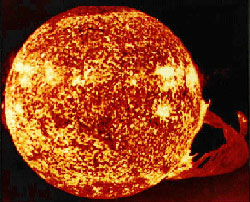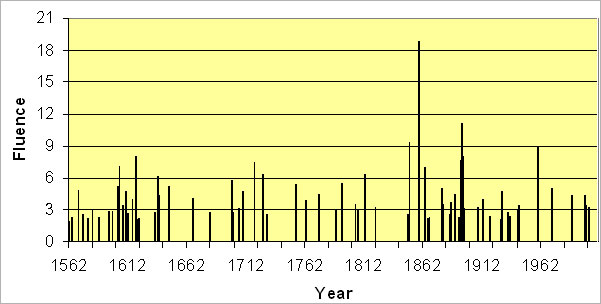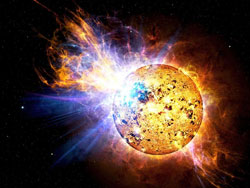National Aeronautics and Space Administration
Goddard Space Flight Center

Sun-Earth Day 2009: Our Sun Yours to Discover
Issue #68: Stellar Explosions; When good stars go bad

Figure 1: On December 19, 1973, astronauts onboard Skylab captured this image of a huge erupting solar prominence. As spectacular as it seemed, it was entirely harmless to Earth and its denizens.(Courtesy - NASA /Skylab)
We complain about the occasional 'solar flare' but surveys of other stars prove that we certainly have a lot to be thankful for!
During the last solar activity cycle, the sun produced over 10,000 solar flares and nearly 1,500 ejections of matter (coronal mass ejections). Only a small number of these events did much more than create a brief electrical blackout or damage a few satellites. One medium-sized storm caused an electrical blackout in Quebec on March 13, 1989 that plunged missions of Canadians into darkness for nearly 12 hours. Before the Space Age, newspapers chronicle a dozen more severe solar storms that were strong enough to cause brief but inconvenient telegraph outages and short-wave blackouts.
Taking a longer view of solar activity, ice core data (Figure 2) reveals only a few storms in the last 500 years that were dramatic in their radiation or particle effects. One of these, the September 2, 1859 'Carrington-Hodgson Flare' is now called a Superstorm because of its intensity and the many impacts that were recorded to telegraph systems worldwide. By some estimates, a storm like this today might cost the world economy at least $1 trillion in damaged electrical and satellite systems, and recovery costs. But it is the only one of its kind seen in the last 500 years.

Figure 2: Ice core data showing the 'spikes' registered for significant solar radiation storms. The tallest one is for the September 2, 1859 'superstorm'. (Dr. Kenneth McCracken (Univ. Maryland))
Lunar rock samples, whose crystalline structure has been scoured by fast-moving particles from countless thousands of solar storms. Geologists can read this record, and from the age of the rock, conclude that the sun has been rather well-behaved during the last 5 million years or so, with about the same level of solar activity as we have experienced during the last 50 years.
But our sun is only one of countless other stars, many of which have a more violent nature.
Other Suns..Other Storms...
The most violent solar flares barely increase the over-all light from our sun by an amount that can be measured by distant observers. Even the most powerful solar flares release only about one trillion trillion Joules of energy in a few minutes, but this is only 0.01% the luminosity of the sun and is utterly undetectable by distant observers in the universe. NASA satellite studies of its ultraviolet output shows that as a star, it is about twice as luminous during sunspot maximum as it is during minimum. But this is still pretty wimpy considering that the rest of the solar 'luminosity' varies hardly at all. The good news is that historical records indicate that no superflares brighter than 100 times what we have seen in the 20th century have occurred on the sun in at least the last 2000 years.
UV Ceti (8.7 light years) - This is one of the best-known 'flare stars' to astronomers, and actually defines an entire class of variable stars. Discovered in 1948, its brightness can suddenly increase by 5 times in a matter of minutes. In 1952 it flared to 75 times its normal brightness in only 20 seconds!
Proxima Centauri (4.2 light years) - This red dwarf star produces flares that are 10,000 more intense than anything our sun produces. They last from minutes to hours, and happen unpredictably. Astronomers believe that these flares are produced in the same way as solar flares, though they involve far more intense magnetic fields and releases of energy.
RS Canum Venaticorum (26 light years) - Stars like this are close binaries in which magnetic fields become tangled between the two stars, releasing intense bursts of energy. These stars are known to have very active chromospheres, and sun-like activity cycles of 5-15 years.

Figure 3: An artist's rendition of a huge flare on the young star EV Lacertae. (NASA / Casey Reed)
EV Lacertae (16 light years) - Young stars tend to have surfaces that are still settling-down from the formation of the star. They also tend to be rotating very fast. Both of these factors make for strong magnetic fields and powerful flares. On April 25, 2008, NASA's Swift satellite detected the flash of light from this nearby star. It was thousands of times more powerful than the most intense solar flare we have observed so far. This star is very young, only 300 million years old, and rotating very fast (every 4 days).
Groombridge 1830 and S Fornacis - Very careful monitoring of selected stars similar to our sun, called solar analogues, show that here have been nine cases of superflares involving 1026-1031 Joules on normal solar-type stars. These stars are of spectral class F8-G8, are single, and they are not young stars that have recently formed. This includes several stars that are known to have orbiting planets. For example, the flare on Groombridge 1830 (distance 30 light years) spotted on April 27, 1939 lasted about 20 minutes and increased the brightness of the entire star by a whopping 75%. This was equal to 1028 Joules. This pales in comparison to the outburst from the star S Fornacis (distance 480 light years) on March 2, 1899 when astronomers saw it brighten by 16 times (that's 1,500 %) in a matter of a few hours. The equivalent energy was 1031 Joules! According to some theories, these solitary stars may have nearby Jupiter-sized planets whose magnetic fields interact with the star's magnetic field to produce these monstrous flares.
Were our sun to flare up like S Fornacis, it would devastate Earth's atmosphere, and perhaps even melt the icy crusts of the Jovian satellites Europa and Ganymede!
The Sun-Earth Connection
Our sun is a magnetically-active star that produces violent storms, but compared to other stars, it is very well-behaved and provides a stable environment for planets supporting living systems.
Space Math Connection:
These problems are available at Space Math @ NASA (http://spacemath.gsfc.nasa.gov)
Super-Fast Solar Flares [Problem 101]
Students will analyze consecutive images taken of an erupting solar flare, and use the information to calculate the speed of the flare. [Grade 6-9; Skills: image scales; time calculation; speed calculation]
Mysterious Solar Micro-flares [Problem 103]
The Hinode satellite detected micro-flares on the solar surface. Students use a Hinode image to measure the size of these flares, and determine how many occur on the solar surface. [Grade 6-9; Skills: image scales; area calculation; unit conversion]
XZ Tauri's Super-CME [Problem 122]
The Hubble Space Telescope spotted a hugs cloud of gas ejected by the star XZ Tauri. Students use consecutive images to measure the average speed and size of the gas cloud leaving the star. [Grade 8-10; Skills: image scale; speed from distance/time]
References:
Odenwald, S., Green, J., 'Bracing for a Solar Superstorm', Scientific American, August, 2008.
Reddy, R. 'Solar Particle Events and Their Radiation Threats', IEEE Nuclear and Space Radiation Effects Conference', Snowmass Colorado, July 22, 1998, pp. 317-323.
Schaefer, B., 2000, 'Superflares on Ordinary Solar-Type Stars', Astrophysical Journal, vol. 529, p. 1026.
Credits:
Dr. Sten Odenwald (Author - Hinode)
2009 ISSUES
View past issues
NASA Fact
During a severe solar storm, Earth loses about 100 tons of its atmosphere into space.
